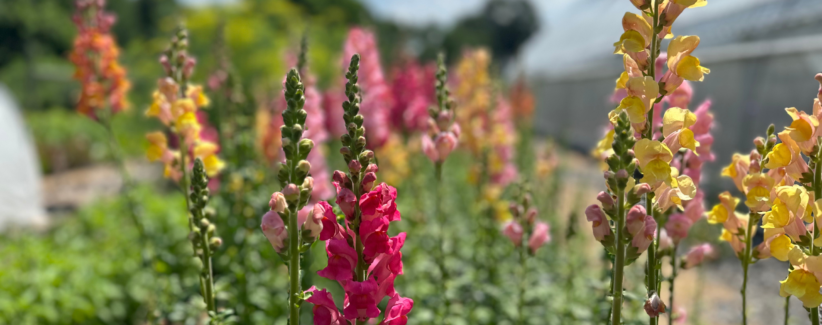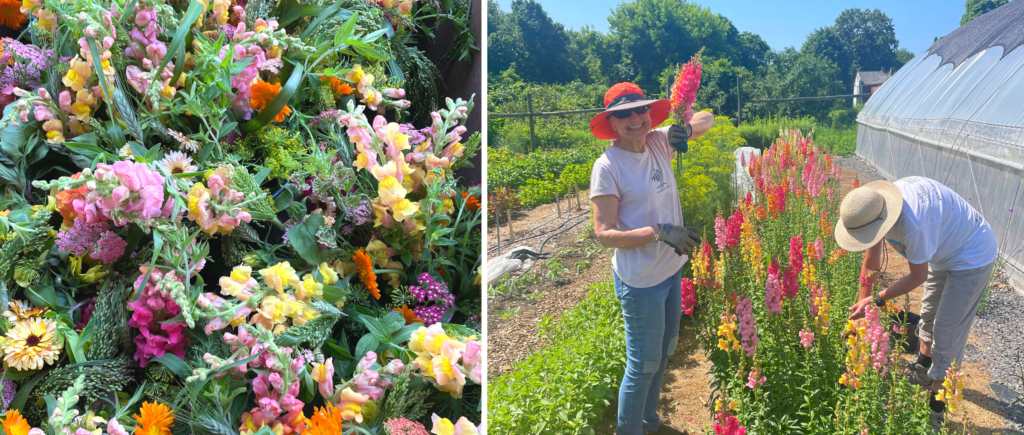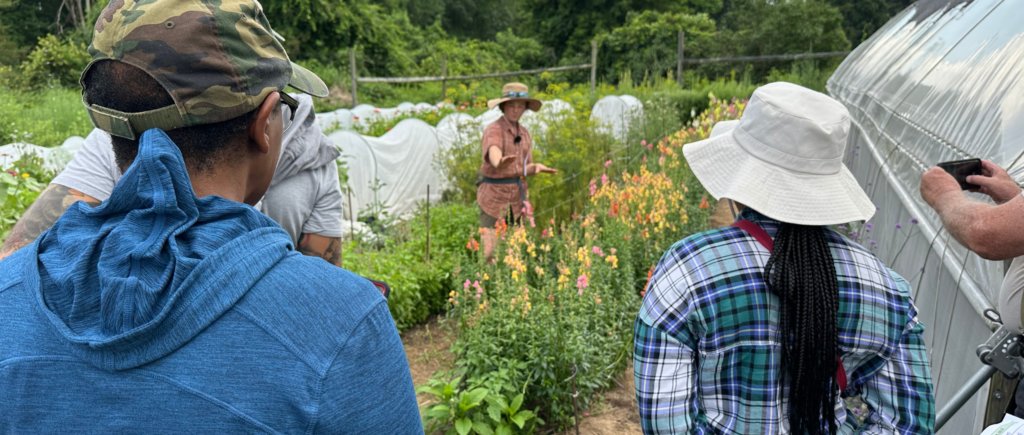The Power of Flowers at Gaining Ground

Summer is in bloom, and the flowers at Gaining Ground are alive with colors, aromas, and even sounds, like the hum of wasps in the celosia.
Each year, in addition to powerhouse veggies and herbs, we are proud to grow and donate a wide variety of cut flowers through Food for Families, a program we began 20 years ago to improve food equity among Concord and Carlisle residents.
From June to September, we provide 120 households a week with free, fresh, organic produce. Come July, we add a special pop of color to people’s shares: farm-fresh flowers, arranged into stunning bouquets every Friday afternoon by three mother-daughter teams of volunteers from the National Charity League.

“People deserve nutrition, and also beauty, delight, and dignity,” said Co-Assistant Farm Manager Kari Bender. “The flowers really bring that. They become the beautiful centerpiece on the table, while the food we donate helps to make the meal.”
This year, having overwintered a large planting of tulips, we were also able to donate early season bouquets to our partners at Open Table in Maynard, Women’s Lunch Place in Boston, and House of Hope in Lowell.
“I cannot get over how beautiful these flowers are,” said Alexandra Depalo, Executive Director of Open Table. “Including flowers in our food distribution and deliveries today will truly brighten people’s day.”
Flowers spark joy. They’re also a meaningful part of the no-till system at Gaining Ground, showing up in cultivated beds (about 1,000 feet of which are dedicated to flowers) and our native hedgerows, which protect the fields from excessive wind and provide sanctuary to beneficial insects and predators. Especially important is the role of flowers in attracting pollinators, who ensure that plants can reproduce and bear fruit, creating a web of life that binds together the farm’s ecosystem.
On a stroll around Gaining Ground, you’ll find yarrow in many shades, sunballs, marigolds, a rainbow of snapdragons, perennial mountain mint, sunflowers, and more. Tansies are ladybug hotels. Butterflies flock to dahlias, hummingbird moths to verbena, and wasps to celosia. Wild bees linger in the pink shade of beach roses.
“Different insects can only feed from certain flowers,” Kari said, “so having diversity is important.”

Diversity is a core value at Gaining Ground, and an essential principle of no-till agriculture. It also makes for striking bouquets, featuring a playful mix-and-match of textures, colors, and shapes. Scabiosa or gomphrena bring a bright flourish, while poppies are grown for the neutral, bulbous seed pods that remain after their delicate petals fall away. Ornamental grasses spill over like green droplets, or feather out.
When the fabulous blue ageratum died in the unexpected late-spring frost, Kari turned to the bachelor’s button to serve a similar purpose in the bouquet. She also took note for next season: the delicate, fuzzy blossom wasn’t very cold tolerant. Neither were the zinnias, amaranth, or celosia.
These are some of the lessons that Kari has learned in her second year overseeing flowers at Gaining Ground, with tutelage from former Greenhouse Manager Kim Schmidt, former Assistant Farm Manager Erin Espinosa, and past experience at Codman Community Farms.
Overall, she said, flower farming is like solving a puzzle. Of course that’s equally true of vegetable and herb farming (which Kari also co-manages), but the flower puzzle pieces could be interpreted as smaller and more particular. For instance, rather than planting and tending to three beds of the same crop—as one would do with lettuce—Kari takes an intensively diverse approach to flower farming. In a single bed, there may be 10 feet of one flower, 15 feet of another, and so on.
“There’s a magic to it—of being out there with the pollinators, the plants, the flowers, and each other,” Kari said. “And it’s still farming. It’s still intense work.”

By July, the prep work for flowers—which get a single succession—is done. Yet care for the plants remains a top priority, especially deadheading so they may produce more blooms. As taller stems reach for the sky, it’s important to stake them for support. And it’s always important to scout for hungry bunnies, who enjoy eating whatever tasty crop is uncovered.
Weekly harvest and bouquet arrangement is most time-consuming. It’s also time-sensitive, happening early in the morning on Fridays before the sun is too high, so fresh flowers don’t succumb to the heat. All this care, skill, and planning takes place so bouquets can end up in the hands and homes of the Concord and Carlisle residents who make up the Food for Families community.
“I love the flowers,” said a participant from 2022. “They add cheer to my kitchen window sill.”
Kari said that annual flowers can even bring a unique beauty to the farm after the season ends. Come winter, she said, when everything has died back, the crew won’t clear the stalks but rather keep them in the soil, to provide ground cover and honor the flow of the environment.
“In nature, they wouldn’t be removed,” Kari said. “It’s also beautiful during the bleak, gray months to see all the golds and browns and different textures in the field.”